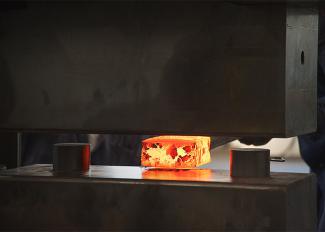Energy trends are changing, which means the nation’s energy infrastructure must change too, including the designs of transformational power technologies like ultra-supercritical steam plants and supercritical carbon-dioxide power systems.
To operate efficiently at higher temperatures and pressures, power plants of the future will need new affordable materials that can deliver both superior corrosion and creep resistance. These alloys can operate in many industrial environments such as such as gas turbines or chemical processing plants without sacrificing the typical lower cost, formability and weldability of conventional high-temperature materials. Such systems will increase efficiency, lower costs and reduce emissions from fossil-fired power cycles, ensuring affordable and reliable energy for the nation well into the future.
The U.S. Department of Energy (DOE) Office of Fossil Energy (FE) eXtremeMAT national laboratory consortium, led by the National Technology Laboratory (NETL), leverages the world-leading expertise and capabilities in the DOE complex associated with materials design, high-performance computing power, advanced manufacturing, in-situ characterization, and performance assessment in an integrated, collaborative, and coordinated effort to address the materials challenges associated with advanced energy systems.
“Building the power plants and industrial facilities of the future is a lengthy and complex process, but with the help of big data and machine learning, we can make the process easier, cheaper and less time-consuming” explained NETL’s Jeffery Hawk, eXtremeMAT’s technical director. “With the latest in simulation and modeling technologies at our disposal, we can predict how some of our alloys samples will perform under pressure without having to conduct physical experiments. It’s about working smarter rather than harder.”
The eXtremeMAT team (consisting of NETL and partner laboratories, Idaho National Laboratory, Los Alamos National Laboratory, Oak Ridge National Laboratory, and Pacific Northwest National Laboratory) has made significant progress in a short period time:
- Developed a suite of physics-based models to predict creep rupture using a limited number of short-term creep tests. The eXtremeMAT models may help accelerate qualification for harsh environment service.
- Developed a first-generation engineering model which incorporates microstructural changes during service, to predict the performance of components subjected to multi-axial stresses and cyclic-loading conditions. This model can be implemented in commercial finite element analysis packages. This eXtremeMAT tool may lead to better prediction of component failure and remaining life during service and enable predictive maintenance practices.
- Identified several affordable alumina forming austenitic steels with enhanced elevated temperature properties compared to state-of-the art high temperature austenitic alloys. These lower cost alloys may lower the costs for systems operating in harsh environments.
The Lab contributed to eXtremeMAT’s advances in the fields of computational multiscale modeling, simulations and data science, which directly contribute to the production of alloys and help all the consortium’s members.
For example, NETL researchers created a database platform on the NETL EDX site to curate experimental and simulation data and metadata required for material data analytics in expediting design and development and material property life prediction. Based on previous NETL research, a database of information on austenitic stainless steels was augmented with datasets on steels, nickel superalloys and high entropy alloys. Datasets from the literature added into the database included dataset from Japan’s National Institute of Materials Science on fatigue. Creep data collected at the University of Texas El Paso was shared with the eXtremeMAT team. These data sets, their creep characteristics, and the accompanying metadata were added to the eXtremeMAT datasets, further bolstering efforts to advance the initiative.
The consortium was also very active regarding outreach and engagement with industry partners. During FY20, eXtremeMAT organized a series of webinars to inform stakeholders about its goals and objectives and several of the recent program accomplishments. These events provided an excellent opportunity for soliciting information about challenges being faced by industry that could be addressed by DOE.
The U.S. Department of Energy’s National Energy Technology Laboratory develops advanced technologies that provide reliable and affordable solutions to America's energy challenges. NETL’s work supports DOE’s mission to advance the national, economic, and energy security of the United States.




